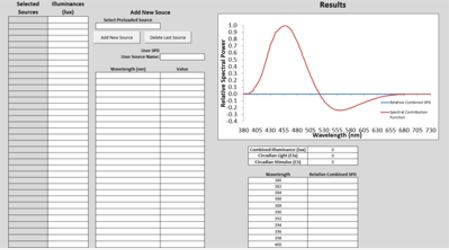The Lighting Research Center has released a new version of its free, open-access circadian stimulus (CS) calculator with more robust and flexible functionality to help lighting professionals select light sources and light levels that will increase the potential for circadian-effective light exposure in architectural spaces.
The new calculator provides additional functions not included in the original version, including the ability to calculate CS levels in rooms with multiple light sources; and combine pre-loaded SPDs from the calculator dropdown and user-supplied SPDs to provide one CS measurement and a single relative SPD.
 |
|
(Image: Lighting Research Center) |
Lighting professionals can use the CS calculator to compare the effectiveness of various light sources for stimulating the circadian system. The CS calculator utilizes the CS metric, a measure of how one-hour exposure to a light source of a certain SPD and light level stimulates the human circadian system, as measured by acute melatonin suppression. Unlike other proposed metrics, such as melanopic lux or melanopic content, the CS metric takes into account both the absolute and the spectral sensitivity of the circadian system, ranging from 0.1, the threshold for circadian system activation, to 0.7, response saturation. The CS metric was developed by the LRC from several lines of biophysical research, including those from basic retinal neurophysiology, has been validated in controlled experiments, and has been used successfully in numerous field applications by the LRC and others. The LRC has found that exposure to a CS of 0.3 or greater at the eye, for at least one hour in the early part of the day, is effective for stimulating the circadian system and is associated with clinically relevant outcomes, such as reductions in depression and agitation among persons with Alzheimer’s disease, entrainment in U.S. Navy submariners, and improved sleep and mood in office workers. Others have also shown that a CS of 0.3 or greater is associated with better sleep in older adults.
In the October 2016 issue of LD+A, LRC researchers discuss the CS metric and present useful tips to help designers create lighting plans that deliver prescribed amounts of CS. In the article, the authors note that, to use the calculator, designers should formulate a base condition by evaluating the space using the CS calculator and commercially available software such as AGi32. The design can later be fine-tuned by again using the CS calculator, while also accommodating IES recommendations, energy codes, and any client workspace specifications.
To access to the CS calculator: http://www.lrc.rpi.edu/programs/lightHealth/index.asp











